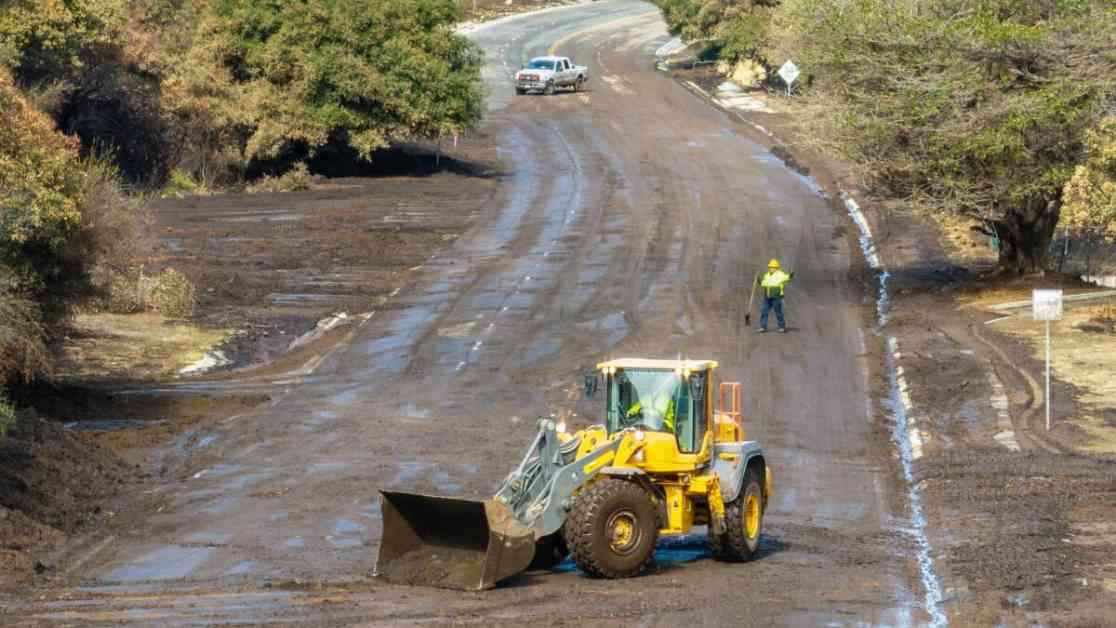Understanding the Risk of Mudslides in Los Angeles County
As the rainstorm approaches Southern California, the threat of debris flows in fire zones looms large. While the rain is set to begin on Wednesday, the most destructive downpours are anticipated for Thursday. In light of this imminent risk, it is crucial to comprehend the potential for debris flows in order to safeguard lives and property.
The Risks of Debris Flows: A Hazardous Consequence of Wildfires
When lush green hillsides are stripped of their protective vegetation due to wildfires, they become susceptible to erosion during heavy storms. This vulnerability can lead to devastating debris flows, where mud, rocks, and dead branches cascade down slopes like whitewater rapids, endangering any structures or individuals in their path. According to U.S. Geological Survey hydrologist Jason Kean, the aftermath of fires alters soil composition, making it resistant to water absorption. The combination of ash, soil clogging, and oily substances impedes the natural percolation of water, causing it to flow rapidly downhill, gathering sediment and debris along the way.
This transformation renders the soil impervious to water infiltration, akin to rain hitting a parking lot or a playground slide, resulting in swift runoff that can trigger hazardous debris flows. The highest risk for such events occurs in the first year or two following a wildfire, with the susceptibility lingering for three to five years until vegetation regrowth stabilizes the area. Each passing year of recovery diminishes the risk, providing a window for communities to prepare and mitigate potential threats.
Preparing for Debris Flows: Tips for Safety and Readiness
To safeguard against the dangers posed by debris flows, it is essential to heed the following precautionary measures recommended by the California Department of Conservation:
– Remain vigilant for debris flows in the aftermath of wildfires for a period of two to five years, as intense rainfall on charred slopes can trigger these events.
– Stay informed by monitoring official weather forecasts, as even brief periods of heavy rain can initiate debris flows. Flash flood alerts issued by the National Weather Service signal impending risks, especially in mountainous regions.
– Avoid complacency based on past experiences, as debris flows can impact new areas or recur in previously affected zones, with varying intensities and patterns.
– Evacuate preemptively before the storm hits, as debris flows move swiftly and waiting to assess the situation can jeopardize safety. Outrunning a debris flow is impossible once it is in motion.
– If sheltering in place becomes necessary, identify a secure location in advance and remain attentive to signs of impending danger. High ground offers a refuge from rising waters and mud, while vigilant monitoring for unusual sounds or movements is critical.
– Respect the unpredictable nature of debris flows, as they can manifest unexpectedly in uncharted territories, necessitating proactive preparations and swift responses.
– Anticipate additional flood risks beyond debris flows, as storm systems capable of triggering these events may also induce conventional flooding hazards.
– Acknowledge the potential for debris flows in non-fire scenarios during wet winters, as saturated soil conditions can prompt similar outcomes to post-fire environments.
– Monitor the surroundings for signs of waterlogged soil, surface erosion, or unusual changes in nearby streams, indicating heightened risks of debris flows.
– Exercise caution by avoiding lower-level sleeping quarters on hillside-facing slopes, as debris flows can engulf such areas, posing grave threats to occupants.
– Enroll in alert systems provided by local emergency management agencies to receive timely notifications and updates on potential hazards.
Distinguishing Landslide Varieties: From Mudflows to Debris Flows
While the term “landslide” encompasses various forms of downhill movements, hydrologists categorize distinct types based on their characteristics:
– Mudflow: Defined by the presence of water mixed with mud, mudflows are shallow landslides typically less than 15 feet in depth.
– Debris Flow: Involving rapid downhill water flow that collects rocks, branches, and larger debris, debris flows constitute a shallower landslide variant.
– Hydrologists often employ the term “mudslide” informally, blending elements of mudflows and landslides to describe debris flows or mudflows more comprehensively.
Understanding the Mechanics of Debris Flows: Precipitation and Consequences
Rainfall rates exceeding half an inch per hour serve as a tipping point for triggering debris flows in recently burned areas. Meteorologist Ryan Kittell from the National Weather Service underscores the significance of intense rainfall intensities above this benchmark in inducing substantial debris flows. Shallow landslides, characterized by localized slope collapses, can occur shortly after intense rain events, posing risks to infrastructure and communities in their vicinity.
Debris flows are not exclusive to post-fire scenarios, as evidenced by past incidents of severe mudflows following heavy rainfall in Southern California neighborhoods. A notable example occurred in Montecito, where a post-fire debris flow claimed lives and properties, underscoring the persistent threat posed by intense precipitation in vulnerable regions. Historical accounts of deadly debris flows, such as the Love Creek disaster in the Santa Cruz Mountains, highlight the catastrophic consequences of natural events that can devastate communities in their path.
Stay tuned for the continuation of this comprehensive overview of landslide risks and mitigation strategies in Los Angeles County.


